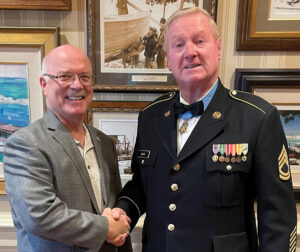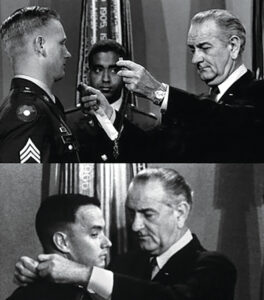By Doug Stauffer
“You don’t lose until you quit trying!” is an oft-repeated quote from Sammy Davis. You might recognize that name, but this Sammy is not an entertainer, he’s a Vietnam War American hero.
 I love to meet inspiring people, but there is always more to the story. These two interrelated stories involve sacrifice, service, honor and selflessness. They illustrate how catastrophic events produce future opportunities – both inspired by and through love. Some events in life are extraordinary; for me, they mainly involve my interactions with genuinely amazing people. We should never take for granted the wonderful people who cross our paths.
I love to meet inspiring people, but there is always more to the story. These two interrelated stories involve sacrifice, service, honor and selflessness. They illustrate how catastrophic events produce future opportunities – both inspired by and through love. Some events in life are extraordinary; for me, they mainly involve my interactions with genuinely amazing people. We should never take for granted the wonderful people who cross our paths.
Brian and Kathy Haugen asked Sammy Davis to be the keynote speaker in a fundraiser for the Taylor Haugen Foundation. Before that event, I was blessed to attend a private luncheon with Sammy and Dixie Davis, Gen. (Rep.) Patt Maney, Col. Jason Grandy and Col. Brian Haugen. Yes, the conversation was indescribable.
In 1965, after high school graduation, Sammy L. Davis enlisted in the Army and volunteered to go to Vietnam. Because his father had been an artilleryman in World War II, he volunteered for the same and was assigned to the 4th Artillery. Davis said he did not go to war to kill people but wanted his dad to be proud of him. He went to war because he loved his daddy, his grandpas, and his country.
The United States was involved in Vietnam from 1965 to 1973, with more than 2 million Americans serving in uniform, including my father. I have met several Medal of Honor recipients, including Gary Beikirch and Woody Williams. This story is about Sgt. 1st Class Sammy L. Davis, another Medal of Honor recipient.
A handful of those 2 million servicemen distinguished themselves with acts of valor. Their actions were considered so far above and beyond the call of duty that they received the highest military honor for valor in combat—the Medal of Honor. Only 248 Vietnam soldiers were presented with the medal, making it a highly exclusive award. Davis was one of those 248. More than half of the medals were awarded posthumously.
 Because Davis shared a name with the famous entertainer, his fellow soldiers sometimes chided him. Many years after his time in the Army, he would again be attached to another entertainer – Tom Hanks as Forrest Gump. Those familiar with the story of Sammy Davis knew he was the “real” Forrest Gump Medal of Honor recipient portrayed in the movie.
Because Davis shared a name with the famous entertainer, his fellow soldiers sometimes chided him. Many years after his time in the Army, he would again be attached to another entertainer – Tom Hanks as Forrest Gump. Those familiar with the story of Sammy Davis knew he was the “real” Forrest Gump Medal of Honor recipient portrayed in the movie.
Early on Nov. 18, 1967, Davis’s unit was helicoptered into an area west of Cai Lay in the Mekong Delta to set up a forward fire-support base – Firebase Cudgel – offering support for the infantrymen operating in the area. Battery C consisted of 11 guns and 42 men.
The following day, at 2 a.m., Battery C came under heavy mortar attack. Thirty minutes later, a reinforced battalion, estimated at 1,500 Vietcong soldiers, launched an intense ground assault. Fortunately, a river separating the two forces hampered the enemy’s advance. Davis’ squad operated a 105 mm Howitzer that fired shells containing 18,000 metal flechettes. A “beehive” round turns the Howitzer shells into a shotgun blast.
An enemy rocket-propelled grenade scored a direct hit on the howitzer, knocking the crew from the weapon, blowing Davis sideways into a foxhole, and knocking him unconscious. He was later struck by friendly fire, which caused him to regain consciousness, and Davis credits this hit with saving his life.
More than 30 razor-sharp one-inch beehive darts passed through his buttocks. Tom Hanks was superimposed over Davis’ head in the footage of President Johnson presenting Davis with the Medal of Honor.
Convinced that the heavily outnumbered Americans couldn’t survive the attack, Davis fired off at least one round from the damaged artillery piece before being overrun. He struggled to his feet, rammed a shell into the gun, and fired point-blank at the Vietcong advancing five deep directly in front of the weapon; the beehive round cut them down.
His wounds included a perforated kidney, crushed ribs, a broken vertebra, ripped flesh from the beehive darts and burns all over his body. He ignored his injuries and crossed the river under heavy fire to rescue three wounded American soldiers. He kept fighting the enemy until they retreated. Only 12 of the 42 soldiers survived that battle. His book, “You Don’t Lose Until You Quit Trying,” chronicles his life.
Later in the day, Davis was shot in the thigh by an enemy AK-47, earning his second purple heart.
When there were no more rounds left, he fired a white phosphorus shell, and then the last round he fired was a “propaganda shell” filled with leaflets.
At this point, he heard yelling from the other side of the river and realized that American soldiers were stranded and needed help. Despite not knowing how to swim, he descended into the water and paddled across on an air mattress, making two trips to bring the three American soldiers to safety. He provided covering fire as another soldier helped the most gravely wounded soldier across the river, then pulled the other two through the water on the air mattress to the fire base.






























































